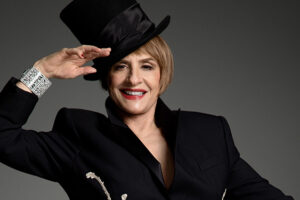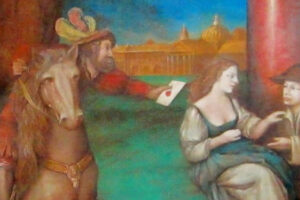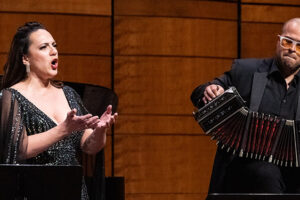

Occasionally stars from the then-fledgling LA Opera would come down and thrill patrons as well. In 1983 the owners asked one of their regular performers, Ann Marie Ketchum, to form an amateur chorus to offer their soloists some proper vocal back-up. When the restaurant closed some years later a core group from the chorus approached Ms. Ketchum with the idea of keeping the group going.
Now, 35 years later, this seemingly motley company has morphed into a nearly 60-person chorus who are dedicated to bringing opera to their community and offers performance opportunities to both aspiring and established singers.
Aside from hiring three or four soloists per concert weekend (one each fall and spring) the chorus employs two section leaders per voice category to help both strengthen their section musically and vocally. Dubbed the Walter Fox Singers, after the founding member who spearheaded the program, these young professionals often fill in solo roles in the ensembles and gain valuable performance experience that they wouldn’t if they were singing a typical “church job.”
A compliment to Ms. Ketchum’s nose for talent is that many of these spaces are refilled on a regular basis as these singers naturally move on to burgeoning careers. Spring of 2016 saw one of our most talented Walter Fox alumni, Baritone Babatunde Akinboboye, elevated to soloist a short while after leaving and he’s since gone on to solo roles with LA Opera and other regional companies.
Another recent soprano section leader, Julia Metzler, was a Western Regional Winner in last month’s Metropolitan Opera National Council Auditions. There are so many young singers trying to bridge the gap between college and career and we’ve been fortunate to have them and offer our support.
My own involvement with the chorus began in 2003, long after I’d covered myself in glory in the Opera Workshops of Santa Monica City College and UCLA, and had settled down into a career in the travel industry. A colleague, who knew my past history as an opera student, convinced me to come in to audition for the tenor section.
Initially I was riding that high-thoroughbred known as “I’m a soloist” and wouldn’t hear of it. So it took her seven years of wearing me down before I finally relented. Initially excited to finally be part of a group of people just like me (fanatical opera devotees with shattered delusions of grandeur) I was surprised to discover that the group was not only incredibly diverse, both by age and vocation, but many of them liked opera passingly but loved singing opera passionately.
Since I’ve joined the Verdi Chorus has participated in community outreach concerts with the LA Philharmonic (try sitting directly behind the largest bass drum you’ve ever seen during Stravinsky’s Firebird. Wowza(!)), been invited by LA Opera to sing at the grand opening of the 2010 Ring Festival, and participated in the American premiere of Olivier Messiaen’s “Chant des déportés” by Jacaranda Music, our esteemed local new music group; a mini-documentary of the performance and preparation for this massive three-minute long work.
Verdi, arguably above all other operatic composers, highlighted the chorus as the voice of society in his work. He elevated their collective participation from the musical background to providing the framework for political conflict and/or social consensus. They are full players in the story being told right from Nabucco onward.
In my time with the chorus I think we’ve performed every number written by our namesake Maestro with the exception of the great Act III concertato from Otello (hint). As a matter of fact the only suspiciously absent names from the list of our repertoire are Rossini, Gluck, and Meyerbeer.
I knew all the good bits from Bizet’s Les Pêcheurs de Perles by heart a decade before the Met mounted it. I’ve been among Mascagni’s Easter celebrants (Cavalleria) and Puccini’s Christmas Eve revellers (Bohème) a half dozen times to say nothing of portraying the denizens of both Heaven and Hell (pick your composer). Luckily it’s nearly impossible to exhaust the operatic choral repertoire and we’ve been blessed with talented soloists who’ve helped us present set pieces from nearly everything from Aida to La Wally.
Since I was sidelined starting in the fall due to a business trip (I had to go to South America with Silversea Cruises) and then this spring by a particularly rapacious bout of the flu (there are steadfast rules about how many rehearsals you can miss) I haven’t sung with the chorus in a year. So Saturday night afforded me my first opportunity to enjoy a Verdi Chorus concert without 10-weeks of rehearsal prep and having to put on my tuxedo.
Our musical home is the 1st United Methodist Church of Santa Monica just a few blocks from where the Verdi Restaurant was back in the day (now renamed and a hangout for young upwardly mobile hipsters). The church’s A-frame design and sizeable wooden beamed interior offer an grateful acoustic for our purposes. Aficionados (like my mother) even say the sound is best in the church’s rear balcony.
The concert opened with Verdi’s I Lombardi and in particular the chorus’s last act lament, “O Signore, dal tetto natio” which found the chorus already in good form. Particular attention was paid to the composer’s markings with his beloved slurred stacatos and hairpin dynamics thoughtfully executed.
Next up were four selections from La forza del destino with the introduction of Mezzo soloist Karin Mushegain as a spirited Preziosilla in Act II’s “Nella guerra” and “Rataplan’. Her bright and chipper stage presence complimenting an attractively slim voice with a nice tangy edge on the top most notes. She was joined by soprano Shana Blake Hill for the “Preghiera” section that proceeds and the chorus split up into sections onstage to differentiate the offstage pilgrims from the inn’s patrons. Ms. Hill provided proof of her pedigree as an audience favorite by making easy work of the unhappy Leonora’s soaring phrases that sailed out over the ensemble.
Next brought the introduction of our debuting tenor soloist Alex Boyer and baritone Ben Lowe, who was such a hit at the recent fall concert he was asked back at the first opportunity. Given the challenge of Act III’s “Solenne in quest’ora” both young gentlemen proved adept at the long lines and tricky tessitura. Filling phrase after phrase with full spinto sound and partnering each other beautifully to the audiences obvious delight. Voices of this size and caliber are rare enough but to hear them so equally matched in duet was a treat.
Five pieces from Nabucco closed the first half starting with “Va, pensiero.” Ms. Ketchum had the chorus leave the choir pews in the rear and take positions, seated or standing, on the steps leading down to the nave, mixing voice types. The effect of this still potent piece of music at such close proximity to the audience providing an extra helping of pathos. Three of the women of the chorus positioned center stage like Mother Courage brought a dramatic focal point to this stirring performance of what is, truly, our anthem.
The opera’s fire and brimstone opening number, “Gli arredi festivi,” brought the chorus back to it’s heated self and bridged the way to the Act I finale. Ms. Hill deliciously flagrant at the very bottom of her range and both she and Mr. Lowe proving themselves more than up for the challenge of Verdi’s declamatory writing. Baritone section leader Mauricio de Palma II rounding out the ensemble as a plush voiced High Priest Zaccaria and Christina Roszhart refulgent as Anna and doing some surprising domination of the ensemble at the ultimo.
Mr. Boyer then gave us the exciting tenor cabaletta that starts with “Che si vuol” his voice ringing out thrillingly over the men of the chorus and displaying a full-fledged muscular spinto that had only been hinted at in the previous numbers. Everyone then reassembling for the first part of the Act II finale, “Sappressan gl’istanti” which found soloists and chorus as one nearly overpowering the 700 seat church with the crescendos of its rocking tempo. It’s honestly a viscerally thrilling experience from the audiences side that I had never experienced.
The second half starting with the lighter bits from Act I of La Traviata, slightly truncated and ending with the departure of the party guests from Violetta’s salon. Ms. Hill once again proved her dextrous versatility with a coquettish courtesan and dotted every grace note and crossed every melisma. Mr Boyer’s tenor seemed almost a size too large at first for the young Alfredo and although his “Libiamo” might have lacked the very last modicum of grace his singing in the duet that followed showed him a master of soft, passionate, singing. A gooseflesh inducing coda from both singers as they brought their flirtation to a close.
Mr. Lowe then favored us with an elegant “Di provenza” which was a model of both legato line and introspection until the final lines and cadenza when he stepped on the gas and gave us his full stentorian fervor. This was easily the highlight of the afternoon for voice aficionados.
The chorus closed out the Traviata chapter with a flirtatious but precise rendition of the opening of Act III with the gypsies and matadors which ended with a whirlwind of musical revelry.
In keeping with the lighter spirit of the second half five selections from Strauss” Die Fledermaus finished the concert starting with the choral introduction to the Act II party segueing into Orlofsky’s “Chacun à son goût” performed by Ms. Mushegain. I can’t recall the name of the famous mezzo (Risë Stevens?) who described the aria as sounding like a bad case of the hiccups but Ms. Mushegain’s portrayal, complete with sly theatrical asides to the audience, was all charm with no trace of indigestion.
Ms. Hill then offered up a frisky Czardas that lacked nothing in luxurious phrasing when the subject turned to her distant “homeland” and was capped with a fearless bravura high note. Then straight through to the end with the soloists all having a turn on the famous “Toast to Champagne.” Mr. Lowe then led everyone in “Sing to love” which brought the evening to its fitting close.
The musical backbone of the chorus is accompanist Laraine Ann Madden who plays far beyond the notes on the printed page. She regularly fills fillng in little bits of orchestration here and there that aren’t in the piano reductions and shows a true rapport with the soloists. She’s the kind of pianist that, after you’ve heard her play, you want to count the number of fingers on her hand because it doesn’t seem possible.
After 35 years, however, the real reason this chorus is still performing and growing musically is Conductor and Artistic Director Anne Marie Ketchum. I speak from personal experience when I say that she is one of those rare musicians who gets everything she wants from the group with her enthusiasm and deep knowledge and appreciation of the music we sing.
She constantly looks for fresh ways to enlighten and inspire and I have never, in 15 years, heard her repeat herself. Nothing is routine. She makes those in her charge strive to work hard and do their best and I have seen our musical standards and accomplishments rise with literally each successive concert. Her beat is clear (it’s important believe me) she knows how all this music should sound, and she has a real skill for programming these concerts,bringing each section to its own musical and theatrical climax, which is something that can’t be taught.
As a group we are truly a musical family and through the music and our comraderies we manage to buoy each other up through the best and the worst. I’m so proud of what we’ve accomplished. The celebration continues in the Fall. Here’s to 35 more.
.























Comments